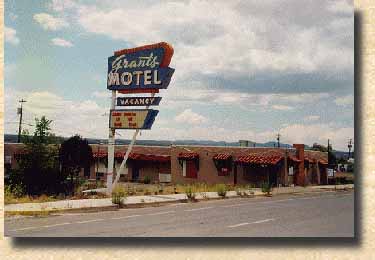 |
|
 |
|
The national outgrowth of the auto camp and tourist home was the cabin camp (sometimes called cottages) that offered minimal comfort at affordable prices. Many of these cottages are still in operation; among the better known examples is John's Modern Cabins in Arlington, Missouri. Eventually, auto camps and cabin camps gave way to motor courts in which all of the rooms were under a single roof. Motor courts offered additional amenities, such as adjoining restaurants, souvenir shops, and swimming pools. Among the more famous still associated with Route 66 are the El Vado and Zia Motor Lodge in Albuquerque, New Mexico.
In the early years of Route 66, service station prototypes were developed regionally through experimentation, and then were adopted universally across the country. Buildings were distinctive as gas stations, yet clearly associated with a particular petroleum company. Most evolved from the simplest "filling station" concept - a house with one or two service pumps in front - and then became more elaborate, with service bays and tire outlets. Among the most outstanding examples of the evolution of gas stations along Route 66 are Soulsby's Shell station in Mount Olive, Illinois; Bob Audettes' gas station complex in Barton, New Mexico; and the Tower Fina Station in Shamrock, Texas.
Route 66 and many points of interest along the way were familiar landmarks by the time a new generation of postwar motorists hit the road in the 1960's. It was during this period that the television series, "Route 66", starring Martin Milner and George Maharis drove into the living rooms of America every Thursday. By today's standards, the show is rather unbelievable but in the 1960's, it brought Americans back to the route looking for new adventure.The Loss of Interest
Excessive truck use during World War II and the comeback of the automobile industry immediately following the war brought great pressure to bear on America's highways. The national highway system had deteriorated to an appalling condition. Virtually all roads were functionally obsolete and dangerous because of narrow pavements and antiquated structural features that reduced carrying capacity.
Ironically, the public lobby for rapid mobility and improved highways that gained Route 66 its enormous popularity in earlier decades also signaled its demise beginning in the mid-1950's. Mass federal sponsorship for an interstate system of divided highways markedly increased with Dwight D. Eisenhower's second term in the 'White House. General Eisenhower had returned from Germany very impressed by the strategic value of Hitler's Autobahn. "During World War II," he recalled later, "I saw the superlative system of German national highways crossing that country and offering the possibility, often lacking in the United States, to drive with speed and safety at the same time."
The congressional response to the president's commitment was the passage of the Federal Aid Highway Act of 1956, which provided a comprehensive financial umbrella to uderwrite the cost of the national interstate and defense highway system.
By 1970, nearly all segments of original Route 66 were replaced by a modern four-lane highway.
In many respects, the physical remains of Route 66 mirror the evolution of highway development in the United States from a rudimentary hodge-podge of state and country roads to a federally subsidized complex of uniform, well-designed interstate expressways. Various alignments of the legendary road, many of which are still detectable, illustrate the evolution of road engineering from coexistence with the surrounding landscape to domination of it.
Route 66 symbolized the renewed spirit of optimism that pervaded the country after economic catastrophe and global war. Often called, "The Main Street of America", it linked a remote and under-populated region with two vital 20th century cities - Chicago and Los Angeles.
The outdated, poorly maintained vestiges of U.S. Highway 66 completely succumbed to the interstate system in October 1984 when the final section of the original road was replaced by Interstate 40 at Williams, Arizona.
As the highway celebrates its 70th birthday this year, its contribution to the nation must be evaluated in the broader context of American social and cultural history. The appearance of U.S. Highway 66 on the American scene coincided with unparalleled economic strife and global instability, yet it hastened the most comprehensive westward movement and economic growth in United States history. Like the early, long-gone trails of the late century, Route 66 helped to spirit a second and perhaps more permanent mass relocation of Americans. We only hope it does not meet the fate of these once-famous arteries.
Help
us save this invaluable piece of Americana before it is only a memory.